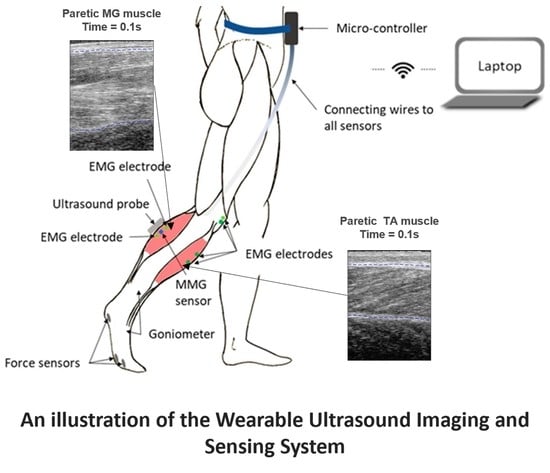How Paretic and Non-Paretic Ankle Muscles Contract during Walking in Stroke Survivors: New Insight Using Novel Wearable Ultrasound Imaging and Sensing Technology
Abstract
:1. Introduction
2. Materials and Methods
2.1. Participants
2.2. Wearable Ultrasound Imaging and Sensing System
2.3. Procedure
2.4. Data and Statistical Analysis
3. Results
3.1. Test–Retest Reliability Result
3.2. Two-Way Repeated ANOVA Result
4. Discussion
5. Conclusions
Author Contributions
Funding
Institutional Review Board Statement
Informed Consent Statement
Data Availability Statement
Conflicts of Interest
References
- Wu, S.; Wu, B.; Liu, M.; Chen, Z.; Wang, W.; Anderson, C.S.; Sandercock, P.; Wang, Y.; Huang, Y.; Cui, L.; et al. Stroke in China: Advances and challenges in epidemiology, prevention, and management. Lancet Neurol. 2019, 18, 394–405. [Google Scholar] [CrossRef]
- Titus, A.W.; Hillier, S.; Louw, Q.A.; Inglis-Jassiem, G. An analysis of trunk kinematics and gait parameters in people with stroke. Afr. J. Disabil. 2018, 7, 310. [Google Scholar] [CrossRef] [PubMed]
- Ling, Y.T.; Ma, C.Z.-H.; Shea, Q.T.K.; Zheng, Y.-P. Sonomechanomyography (SMMG): Mapping of Skeletal Muscle Motion Onset during Contraction Using Ultrafast Ultrasound Imaging and Multiple Motion Sensors. Sensors 2020, 20, 5513. [Google Scholar] [CrossRef] [PubMed]
- Ma, C.Z.-H.; Ren, L.-J.; Cheng, C.L.-K.; Zheng, Y.-P. Mapping of Back Muscle Stiffness along Spine during Standing and Lying in Young Adults: A Pilot Study on Spinal Stiffness Quantification with Ultrasound Imaging. Sensors 2020, 20, 7317. [Google Scholar] [CrossRef] [PubMed]
- Ren, L.J.; Wang, L.K.; Ma, C.Z.-H.; Yang, Y.X.; Zheng, Y.P. Effect of Conventional Physiotherapy on Pain and Muscle Stiffness inPatients with Low Back Pain Assessed by a Wireless Hand-held TissueUltrasound Palpation System (TUPS). Int. J. Phys. Med. Rehabil. 2019, 7, 1–5. [Google Scholar]
- Ren, L.-J.; Cheng, C.L.-K.; Ma, C.Z.-H.; Zheng, Y.-P. Changes in Muscle Hardness from Resting to Mid-Range Lengthened Positions Detected by Shear Wave Elastography (SWE) with a Novel Protocol of Ultrasound Probe Placement. Appl. Sci. 2021, 11, 452. [Google Scholar] [CrossRef]
- Huang, Z.-H.; Ma, C.Z.-H.; Wang, L.-K.; Wang, X.-Y.; Fu, S.-N.; Zheng, Y.-P. Real-Time Visual Biofeedback via Wearable Ultrasound Imaging Can Enhance the Muscle Contraction Training Outcome of Young Adults. J. Strength Cond. Res. 2022, 36, 941–947. [Google Scholar] [CrossRef] [PubMed]
- Kwong, E.; Ng, K.-W.K.; Leung, M.-T.; Zheng, Y.-P. Application of ultrasound biofeedback to the learning of the mendelsohn maneuver in non-dysphagic adults: A pilot study. Dysphagia 2021, 36, 650–658. [Google Scholar] [CrossRef] [PubMed]
- Ma, C.Z.; Ling, Y.T.; Shea, Q.T.K.; Wang, L.K.; Wang, X.Y.; Zheng, Y.P. Towards Wearable Comprehensive Capture and Analysis of Skeletal Muscle Activity during Human Locomotion. Sensors 2019, 19, 195. [Google Scholar] [CrossRef] [PubMed] [Green Version]
- Berg, K.O.; Wood-Dauphinee, S.L.; Williams, J.I.; Maki, B. Measuring balance in the elderly: Validation of an instrument. Can. J. Public Health Rev. Can. Sante Publique 1992, 83, S7–S11. [Google Scholar]
- Banks, C.L.; Huang, H.J.; Little, V.L.; Patten, C. Electromyography Exposes Heterogeneity in Muscle Co-Contraction following Stroke. Front. Neurol. 2017, 8, 699. [Google Scholar] [CrossRef] [PubMed] [Green Version]



| No. | Gender | Cause of Stroke | Age | Weight (kg) | Height (cm) | Paretic Leg | BBS Score (0–56) |
|---|---|---|---|---|---|---|---|
| 1 | F | Hemorrhagic | 60 | 75.2 | 154.0 | Left | 31 |
| 2 | M | Ischemic | 68 | 66.9 | 168.0 | Right | 48 |
| 3 | M | Ischemic | 53 | 78.7 | 172.4 | Left | 49 |
| 4 | F | Hemorrhagic | 55 | 55.5 | 156.5 | Right | 51 |
| 5 | F | Hemorrhagic | 63 | 51.0 | 150.3 | Right | 52 |
| 6 | F | Hemorrhagic | 39 | 49.1 | 155.3 | Right | 53 |
| 7 | M | Hemorrhagic | 55 | 63.0 | 166.0 | Right | 55 |
| 8 | M | Ischemic | 61 | 54.8 | 152.0 | Left | 56 |
| 9 | F | Ischemic | 63 | 58.2 | 163.0 | Right | 56 |
Publisher’s Note: MDPI stays neutral with regard to jurisdictional claims in published maps and institutional affiliations. |
© 2022 by the authors. Licensee MDPI, Basel, Switzerland. This article is an open access article distributed under the terms and conditions of the Creative Commons Attribution (CC BY) license (https://creativecommons.org/licenses/by/4.0/).
Share and Cite
Lyu, P.-Z.; Zhu, R.T.-L.; Ling, Y.T.; Wang, L.-K.; Zheng, Y.-P.; Ma, C.Z.-H. How Paretic and Non-Paretic Ankle Muscles Contract during Walking in Stroke Survivors: New Insight Using Novel Wearable Ultrasound Imaging and Sensing Technology. Biosensors 2022, 12, 349. https://doi.org/10.3390/bios12050349
Lyu P-Z, Zhu RT-L, Ling YT, Wang L-K, Zheng Y-P, Ma CZ-H. How Paretic and Non-Paretic Ankle Muscles Contract during Walking in Stroke Survivors: New Insight Using Novel Wearable Ultrasound Imaging and Sensing Technology. Biosensors. 2022; 12(5):349. https://doi.org/10.3390/bios12050349
Chicago/Turabian StyleLyu, Pei-Zhao, Ringo Tang-Long Zhu, Yan To Ling, Li-Ke Wang, Yong-Ping Zheng, and Christina Zong-Hao Ma. 2022. "How Paretic and Non-Paretic Ankle Muscles Contract during Walking in Stroke Survivors: New Insight Using Novel Wearable Ultrasound Imaging and Sensing Technology" Biosensors 12, no. 5: 349. https://doi.org/10.3390/bios12050349







